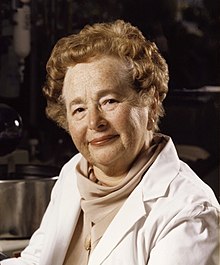Gertrude Elion
| Gertrude Elion | |
|---|---|
 |
|
| Born | Gertrude Belle Elion January 23, 1918 New York City, United States |
| Died | February 21, 1999 (aged 81) Chapel Hill, North Carolina, USA |
| Citizenship | United States |
| Institutions | |
| Alma mater | Hunter College |
| Notable awards |
|
|
Website www |
|
Gertrude Belle Elion (January 23, 1918 – February 21, 1999) was an American biochemist and pharmacologist, who shared the 1988 Nobel Prize in Physiology or Medicine with George H. Hitchings and Sir James Black. Working alone as well as with Hitchings and Black, Elion developed a multitude of new drugs, using innovative research methods that would later lead to the development of the AIDS drug AZT. She developed the first immunosuppressive drug, azathioprine, used for organ transplants.
Elion was born in New York City on January 23, 1918, to parents Robert Elion, a Lithuanian immigrant and a dentist, and Bertha Cohen, a Polish immigrant. Her family lost their wealth after the Wall Street Crash of 1929. When she was 15, her grandfather died of cancer, instilling in her a desire to do all she could to try and cure the disease. She graduated from Hunter College in 1937 with a degree in chemistry and New York University (M.Sc.) in 1941, while working as a high school teacher during day time. Her fifteen fellowship applications were turned down due to gender bias at the time, so she enrolled in a secretarial school, which lasted six weeks before she found a job.
Unable to obtain a graduate research position, she worked as a food quality supervisor at A&P supermarkets, and for a food lab in New York, testing the acidity of pickles and the color of egg yolk going into mayonnaise. Later, she left to work as an assistant to George H. Hitchings at the Burroughs-Wellcome pharmaceutical company in Tuckahoe, New York (now GlaxoSmithKline). Hitchings was using a new way of developing drugs, by imitating natural compounds instead of through trial and error. He believed that if he could trick cancer cells into accepting artificial compounds for growth, they could be destroyed without also destroying normal cells. She began to work with purines, and in 1950, she developed the anti-cancer drugs tioguanine and 6-MP.
...
Wikipedia
